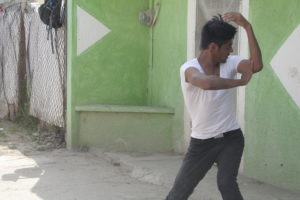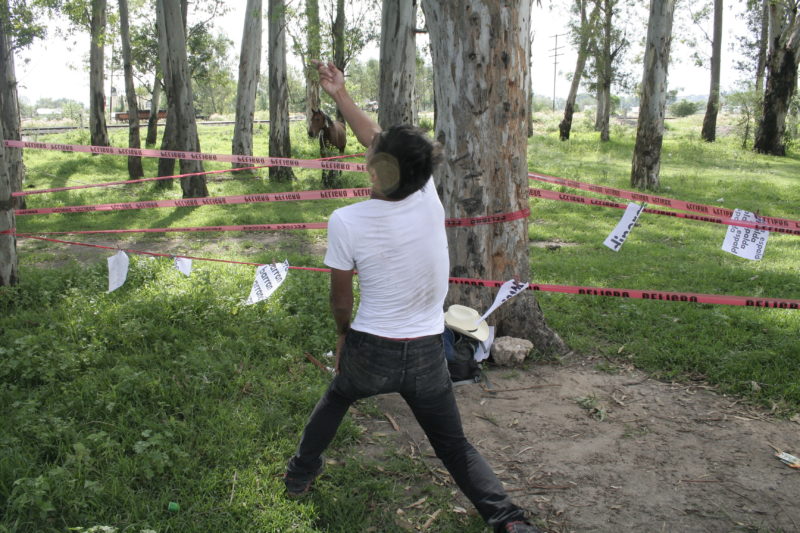As a dancer and choreographer, I always expected I would experience an injury, but I never imagined it would be something so significant as re-learning to walk, shower, and eat. Neither did I imagine I would learn how to dance with PTSD. In 2017, I suffered a near-death experience in Mexico City during the turbulent week of September when catastrophic earthquakes left hundreds dead. I was there to conduct research about dance companies that formed in the aftermath of the 1985 earthquake that left the city in ruins and thousands dead. Coincidently, thirty-two years later, I experienced a tectonic shift too after falling from the third story as I evacuated a building. I have yet to process the entirety of my traumatic experience but I am starting to describe my non-linear recovery path from the past two years. One of my central concerns is examining how I dance after a near-death experience that left me with new disabilities and sensibilities. I have come to see that relearning to dance after a near-death experience is about developing new sensibilities towards my muscles that I had not known before.
Prior to the accident, my dance training included high activity movement and performance practices. I received my BFA from the University of Utah’s dance program. The curriculum resembled a conservative school with its emphasis on providing students long hours in the studio and teaching them various dance genres. From the early morning to late evening, I loved taking classes in modern technique, Contact Improvisation, Congolese, somatics, ballet, jazz, kinesiology, composition, and many others. I also had the honor of being part of the school’s performance dance company for three years, which rehearsed after classes into the late evening.
My professional experience after my time in the dance program was no different. I went on to be a founding member of the improvisational dance company Movement Forum (MoFo), dance in professional companies, and I became an independent choreographer. With MoFo, I danced in public spaces and in all-weather conditions. One of the most memorable performances was dancing outside in the middle of winter for the New Year’s Eve party outside of Abravanel Hall. I spent the summer of 2006 in Iowa City dancing for Elloy Barragan’s contemporary ballet dance company. From 2007-2009, I danced for Dance Koester Dance, a company whose choreographic style and process was notorious for being emotionally and physically demanding. Everyone wanted to dance for Steve Koester because of his fast-paced, high affect, and intricate partnering sequences and I was part of a fortunate few who had that honor. From 2011-2013, I had the privilege of getting my Master’s in England and Serbia while conducting performance research in my birth country, Mexico. I choreographed dances with a tenacity to avoid repetition, always wanting the works to be exhausting—mirroring the overtiredness I experienced and saw in my working-class immigrant family and communities. In all of these settings and spaces, I relished the feeling of my body activating the fast-twitch muscles that gave me the ability to complete powerful bursts of movement in and out of the floor or in contact with other people.
Mind you, my love for moving freely was despite, or rather because of, the multiple social and legal barriers of mobility I experienced. As a formerly-undocumented queer person of color from a working-class family who arrived to this country at age six, I was fully aware of the limits of mobility. In majority Latino spaces, machistas were suspicious of me because I was non-gender conforming. In Serbia, I was accused of terrorism for dancing on the street. In multiple states, I was accosted for being brown. When driving, I always looked in the rearview mirror for police officers. These limitations intersected with the advancement of my creative process. For example, in 2010, I had the opportunity to present a piece I co-choreographed with Molly Heller for a dance festival in New York. Lacking a federal or state-issued ID, I could not fly. I took a Greyhound bus from Utah to New York; it took me six days, there and back, to present an eleven-minute duet. Yet the borders were not limited to transportation. I was not able to apply for federal or state grants for my shows due to my undocumented status. For this reason, in 2011, I decided to go back to Mexico and start the process of becoming a Legal Permanent Resident in the US. Hence, my adoration for dancing fiercely and freely gave me what I could not access legally and socially. It was a freedom I found as a sophomore in high-school when I began taking formal modern dance classes from Becky Dyer, complementing my love for cumbia and the sense of home the social dance provided to me.

The accident in 2017 took away dance as I knew it, removing one of main sources of what I had come to identify as my source of freedom. I was evacuated out of Mexico and spent four months bed-bound to recover from complex fractures sustained on the right-side leg, hip, and elbow—all of which required major reconstruction surgeries. I was bed-bound for most of the day and would use a wheelchair when I got up to the bathroom. Medical staff at the hospital would bathe me. After I was cleared to put weight on my foot in early January 2018, I started to work on my physical therapy regime. I had the double challenge of having the entire right side of my body injured, which prevented me from being able to use a walker because I could not put weight on my elbow until it healed. This situation delayed the time I could put weight on my leg. Physical and occupational therapists would visit my house at least four times a week as part of home health care. At one point in time, I had twelve specialists facilitating rigorous exercises to get my range of motion back and to make sure my muscles were not atrophying. Their aim was to increase the muscle mass on my legs and glutes so I could hold myself up when I walked. Making the recovery worse, I had developed vertigo from the movement of the earthquake. I would get dizzy if I moved my head too fast. Also, any alarms would cause distress. I detested movement, and desired nothing but rest and stillness. I used to love movement, but the destructive shaking of the earth tested the limits of that love. Movement became the antithesis of my freedom.
The accident has challenged me to reconsider what dance looks and feels like. I have been asking myself “What is dance in the face of near-death?” every day for the past eighteen months as my abilities have changed. Right after my first surgery, I did an improvisational dance with my right hand. When my family visited for the first time, I danced with my dad on the bed to Down AKA Kilo’s “Lean Like a Cholo.” I danced cumbia in a wheelchair to bring in the 2019 New Year. I did a trio with crutches in my backyard. I danced with a limp when I took a Zumba class with my mom. With Jose Navarrete, I taught a workshop for FRESH Festival and I was always on the verge of an anxiety attack. Recently, I have been dancing with chronic pain. I avoid sitting too long because my muscles get stiff. I avoid standing too long because my bones ache. My life is dictated by a constant list of actions and movements to avoid, or positions that need constant modification. Dance has become an uncomfortable reminder of what I can and cannot do. Rather than providing freedom, dance marks the limits of my physical comfort.

The past year and a half I have been asking myself what dance after a near-death experience looks and feels like, and I have come to see that the prepositional “near” in near-death has brought me to one of the closest elements possible: my muscles. In January of 2018, my right elbow stopped recovering its range of motion. The muscles were stiffing up. One day, as I massaged my biceps and the elbow to prevent the build-up of scar tissue, I felt my muscles wanting to cry. I began listening to them as their whimpers expressed they still were traumatized from my fall from the third story building. They were having a hard time relaxing in the new environment, being unsure if it was time to relax. They were in crisis mode still. The adrenaline had crystallized between the muscles’ fibers. My bicep wanted to hear from me that it was time to heal. So I said, “Thank you for all you did to protect me during the fall. You did a fabulous job contracting and helping the elbow bone take the impact. I am so grateful for you. You protected the vital organs. You are vital too. It is okay to ease up now. You don’t have to be scared anymore. You have done your job.” At that moment, my bicep muscle and I cried together. Fue un desahogo total. I felt it release tension and I was able to increase my elbow’s range of motion. More important than seeing the increased range of motion, I was thankful to hear my muscle speak. No doctor instructed me to talk to my muscle. Quite the opposite, the doctors asked me if I was talking to a mental therapist when I mentioned to them that I was talking to my muscles. My bicep advocated for itself. I regretted not having listened to it any sooner than that moment.
Now that high affect dance is no longer freedom but only frustration to me, I have learned to talk to my muscles as a central part of my healing. It is through them that my body has become the studio. My body has become a site-specific location. My body has become an international collaborator. I have been at the gym or physical therapy five to six times a week for the past eighteen months. The weight machines are my contact improvisation companions. The vibratory sound of the same playlist has been on repeat for half a year. I have learned to talk to my muscles, and we are creating a language of our own as we listen to each other. My muscles and I have come to call this low affect process rephabulous. The word rehab is hidden inside of this motivational phrase because this rehabilitation process is about acknowledging the fabulousness of my muscles, seeing them in all of their glory and all of their struggles. However, my goal is not only prioritizing the fast-twitch muscles to be the high affect performing fibers that they used to be. Instead, I want to linger in the slow-twitch muscles too. The ones that sustain the long-endurance movement. And so, I am relearning to dance after this near-death experience with a new sensibility where I hear my muscles and the way they speak, love, and care for me. We are taking care of each other anew. The simple articulation of a single muscle moving slowly is freedom and agency on its own.
Upcoming for Juan Manuel Aldape Muñoz: Festival of Latin American Contemporary Choreographers (FLACC), Nov 15-23, flaccdanza.org; NAKA Dance Theater + Mujeres Unidas y Activas present BUSCARTE: May 2020, nakadancetheater.com.
This article appeared in the June 2019 issue of In Dance.


